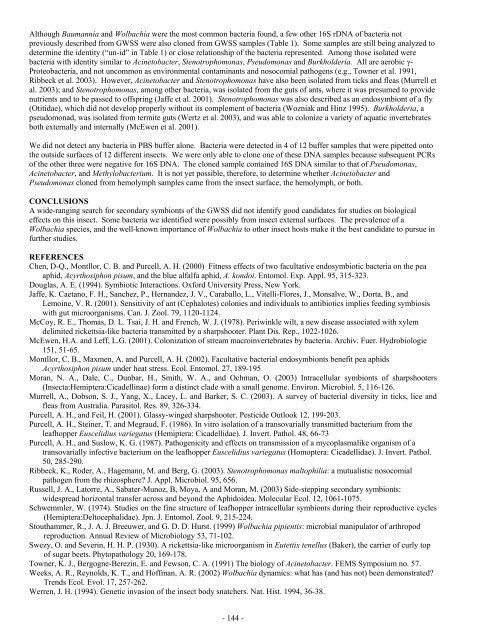Impact Of Host Plant Xylem Fluid On Xylella Fastidiosa Multiplication ...
Impact Of Host Plant Xylem Fluid On Xylella Fastidiosa Multiplication ...
Impact Of Host Plant Xylem Fluid On Xylella Fastidiosa Multiplication ...
You also want an ePaper? Increase the reach of your titles
YUMPU automatically turns print PDFs into web optimized ePapers that Google loves.
Although Baumannia and Wolbachia were the most common bacteria found, a few other 16S rDNA of bacteria not<br />
previously described from GWSS were also cloned from GWSS samples (Table 1). Some samples are still being analyzed to<br />
determine the identity (“un-id” in Table 1) or close relationship of the bacteria represented. Among those isolated were<br />
bacteria with identity similar to Acinetobacter, Stenotrophomonas, Pseudomonas and Burkholderia. All are aerobic γ-<br />
Proteobacteria, and not uncommon as environmental contaminants and nosocomial pathogens (e.g., Towner et al. 1991,<br />
Ribbeck et al. 2003). However, Acinetobacter and Stenotrophomonas have also been isolated from ticks and fleas (Murrell et<br />
al. 2003); and Stenotrophomonas, among other bacteria, was isolated from the guts of ants, where it was presumed to provide<br />
nutrients and to be passed to offspring (Jaffe et al. 2001). Stenotrophomonas was also described as an endosymbiont of a fly<br />
(Otitidae), which did not develop properly without its complement of bacteria (Wozniak and Hinz 1995). Burkholderia, a<br />
pseudomonad, was isolated from termite guts (Wertz et al. 2003), and was able to colonize a variety of aquatic invertebrates<br />
both externally and internally (McEwen et al. 2001).<br />
We did not detect any bacteria in PBS buffer alone. Bacteria were detected in 4 of 12 buffer samples that were pipetted onto<br />
the outside surfaces of 12 different insects. We were only able to clone one of these DNA samples because subsequent PCRs<br />
of the other three were negative for 16S DNA. The cloned sample contained 16S DNA similar to that of Pseudomonas,<br />
Acinetobacter, and Methylobacterium. It is not yet possible, therefore, to determine whether Acinetobacter and<br />
Pseudomonas cloned from hemolymph samples came from the insect surface, the hemolymph, or both.<br />
CONCLUSIONS<br />
A wide-ranging search for secondary symbionts of the GWSS did not identify good candidates for studies on biological<br />
effects on this insect. Some bacteria we identified were possibly from insect external surfaces. The prevalence of a<br />
Wolbachia species, and the well-known importance of Wolbachia to other insect hosts make it the best candidate to pursue in<br />
further studies.<br />
REFERENCES<br />
Chen, D-Q., Montllor, C. B. and Purcell, A. H. (2000) Fitness effects of two facultative endosymbiotic bacteria on the pea<br />
aphid, Acyrthosiphon pisum, and the blue alfalfa aphid, A. kondoi. Entomol. Exp. Appl. 95, 315-323.<br />
Douglas, A. E. (1994). Symbiotic Interactions. Oxford University Press, New York.<br />
Jaffe, K. Caetano, F. H., Sanchez, P., Hernandez, J. V., Caraballo, L., Vitelli-Flores, J., Monsalve, W., Dorta, B., and<br />
Lemoine, V. R. (2001). Sensitivity of ant (Cephalotes) colonies and individuals to antibiotics implies feeding symbiosis<br />
with gut microorganisms. Can. J. Zool. 79, 1120-1124.<br />
McCoy, R. E., Thomas, D. L. Tsai, J. H. and French, W. J. (1978). Periwinkle wilt, a new disease associated with xylem<br />
delimited rickettsia-like bacteria transmitted by a sharpshooter. <strong>Plant</strong> Dis. Rep., 1022-1026.<br />
McEwen, H.A. and Leff, L.G. (2001). Colonization of stream macroinvertebrates by bacteria. Archiv. Fuer. Hydrobiologie<br />
151, 51-65.<br />
Montllor, C. B., Maxmen, A. and Purcell, A. H. (2002). Facultative bacterial endosymbionts benefit pea aphids<br />
Acyrthosiphon pisum under heat stress. Ecol. Entomol. 27, 189-195<br />
Moran, N. A., Dale, C., Dunbar, H., Smith, W. A., and Ochman, O. (2003) Intracellular symbionts of sharpshooters<br />
(Insecta:Hemiptera:Cicadellinae) form a distinct clade with a small genome. Environ. Microbiol. 5, 116-126.<br />
Murrell, A., Dobson, S. J., Yang, X., Lacey, L. and Barker, S. C. (2003). A survey of bacterial diversity in ticks, lice and<br />
fleas from Australia. Parasitol. Res. 89, 326-334.<br />
Purcell, A. H., and Feil, H. (2001). Glassy-winged sharpshooter. Pesticide Outlook 12, 199-203.<br />
Purcell, A. H., Steiner, T. and Megraud, F. (1986). In vitro isolation of a transovarially transmitted bacterium from the<br />
leafhopper Euscelidius variegatus (Hemiptera: Cicadellidae). J. Invert. Pathol. 48, 66-73<br />
Purcell, A. H., and Suslow, K. G. (1987). Pathogenicity and effects on transmission of a mycoplasmalike organism of a<br />
transovarially infective bacterium on the leafhopper Euscelidius variegatus (Homoptera: Cicadellidae). J. Invert. Pathol.<br />
50, 285-290.<br />
Ribbeck, K., Roder, A., Hagemann, M. and Berg, G. (2003). Stenotrophomonas maltophilia: a mutualistic nosocomial<br />
pathogen from the rhizosphere? J. Appl. Microbiol. 95, 656.<br />
Russell, J. A., Latorre, A., Sabater-Munoz, B, Moya, A and Moran, M. (2003) Side-stepping secondary symbionts:<br />
widespread horizontal transfer across and beyond the Aphidoidea. Molecular Ecol. 12, 1061-1075.<br />
Schwemmler, W. (1974). Studies on the fine structure of leafhopper intracellular symbionts during their reproductive cycles<br />
(Hemiptera:Deltocephalidae). Jpn. J. Entomol. Zool. 9, 215-224.<br />
Stouthammer, R., J. A. J. Breeuwer, and G. D. D. Hurst. (1999) Wolbachia pipientis: microbial manipulator of arthropod<br />
reproduction. Annual Review of Microbiology 53, 71-102.<br />
Swezy, O. and Severin, H. H. P. (1930). A rickettsia-like microorganism in Eutettix tenellus (Baker), the carrier of curly top<br />
of sugar beets. Phytopathology 20, 169-178.<br />
Towner, K. J., Bergogne-Berezin, E. and Fewson, C. A. (1991) The biology of Acinetobacter. FEMS Symposium no. 57.<br />
Weeks, A. R., Reynolds, K. T., and Hoffman, A. R. (2002) Wolbachia dynamics: what has (and has not) been demonstrated?<br />
Trends Ecol. Evol. 17, 257-262.<br />
Werren, J. H. (1994). Genetic invasion of the insect body snatchers. Nat. Hist. 1994, 36-38.<br />
- 144 -











